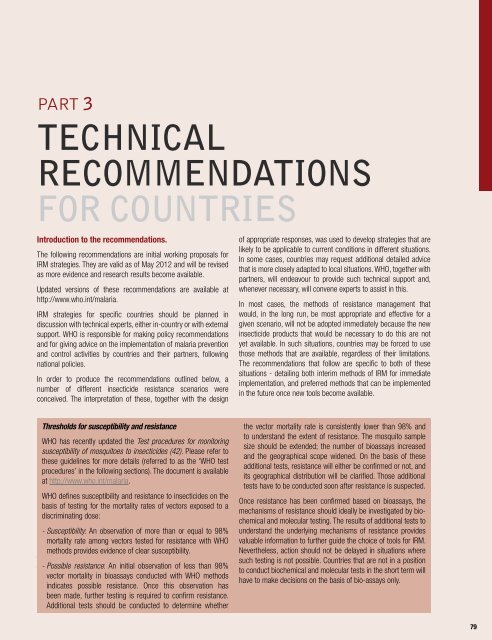Global plan for insecticide resistance management in malaria vectors
Global plan for insecticide resistance management in malaria vectors
Global plan for insecticide resistance management in malaria vectors
- No tags were found...
You also want an ePaper? Increase the reach of your titles
YUMPU automatically turns print PDFs into web optimized ePapers that Google loves.
PART 3TECHNICALRECOMMENDATIONSFOR COUNTRIESIntroduction to the recommendations.The follow<strong>in</strong>g recommendations are <strong>in</strong>itial work<strong>in</strong>g proposals <strong>for</strong>IRM strategies. They are valid as of May 2012 and will be revisedas more evidence and research results become available.Updated versions of these recommendations are available athttp://www.who.<strong>in</strong>t/<strong>malaria</strong>.IRM strategies <strong>for</strong> specific countries should be <strong>plan</strong>ned <strong>in</strong>discussion with technical experts, either <strong>in</strong>-country or with externalsupport. WHO is responsible <strong>for</strong> mak<strong>in</strong>g policy recommendationsand <strong>for</strong> giv<strong>in</strong>g advice on the implementation of <strong>malaria</strong> preventionand control activities by countries and their partners, follow<strong>in</strong>gnational policies.In order to produce the recommendations outl<strong>in</strong>ed below, anumber of different <strong><strong>in</strong>secticide</strong> <strong>resistance</strong> scenarios wereconceived. The <strong>in</strong>terpretation of these, together with the designof appropriate responses, was used to develop strategies that arelikely to be applicable to current conditions <strong>in</strong> different situations.In some cases, countries may request additional detailed advicethat is more closely adapted to local situations. WHO, together withpartners, will endeavour to provide such technical support and,whenever necessary, will convene experts to assist <strong>in</strong> this.In most cases, the methods of <strong>resistance</strong> <strong>management</strong> thatwould, <strong>in</strong> the long run, be most appropriate and effective <strong>for</strong> agiven scenario, will not be adopted immediately because the new<strong><strong>in</strong>secticide</strong> products that would be necessary to do this are notyet available. In such situations, countries may be <strong>for</strong>ced to usethose methods that are available, regardless of their limitations.The recommendations that follow are specific to both of thesesituations - detail<strong>in</strong>g both <strong>in</strong>terim methods of IRM <strong>for</strong> immediateimplementation, and preferred methods that can be implemented<strong>in</strong> the future once new tools become available.Thresholds <strong>for</strong> susceptibility and <strong>resistance</strong>WHO has recently updated the Test procedures <strong>for</strong> monitor<strong>in</strong>gsusceptibility of mosquitoes to <strong><strong>in</strong>secticide</strong>s (42). Please refer tothese guidel<strong>in</strong>es <strong>for</strong> more details (referred to as the ‘WHO testprocedures’ <strong>in</strong> the follow<strong>in</strong>g sections). The document is availableat http://www.who.<strong>in</strong>t/<strong>malaria</strong>.WHO def<strong>in</strong>es susceptibility and <strong>resistance</strong> to <strong><strong>in</strong>secticide</strong>s on thebasis of test<strong>in</strong>g <strong>for</strong> the mortality rates of <strong>vectors</strong> exposed to adiscrim<strong>in</strong>at<strong>in</strong>g dose:- Susceptibility: An observation of more than or equal to 98%mortality rate among <strong>vectors</strong> tested <strong>for</strong> <strong>resistance</strong> with WHOmethods provides evidence of clear susceptibility.- Possible <strong>resistance</strong>: An <strong>in</strong>itial observation of less than 98%vector mortality <strong>in</strong> bioassays conducted with WHO methods<strong>in</strong>dicates possible <strong>resistance</strong>. Once this observation hasbeen made, further test<strong>in</strong>g is required to confirm <strong>resistance</strong>.Additional tests should be conducted to determ<strong>in</strong>e whetherthe vector mortality rate is consistently lower than 98% andto understand the extent of <strong>resistance</strong>. The mosquito samplesize should be extended; the number of bioassays <strong>in</strong>creasedand the geographical scope widened. On the basis of theseadditional tests, <strong>resistance</strong> will either be confirmed or not, andits geographical distribution will be clarified. Those additionaltests have to be conducted soon after <strong>resistance</strong> is suspected.Once <strong>resistance</strong> has been confirmed based on bioassays, themechanisms of <strong>resistance</strong> should ideally be <strong>in</strong>vestigated by biochemicaland molecular test<strong>in</strong>g. The results of additional tests tounderstand the underly<strong>in</strong>g mechanisms of <strong>resistance</strong> providesvaluable <strong>in</strong><strong>for</strong>mation to further guide the choice of tools <strong>for</strong> IRM.Nevertheless, action should not be delayed <strong>in</strong> situations wheresuch test<strong>in</strong>g is not possible. Countries that are not <strong>in</strong> a positionto conduct biochemical and molecular tests <strong>in</strong> the short term willhave to make decisions on the basis of bio-assays only.79
















